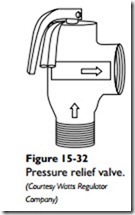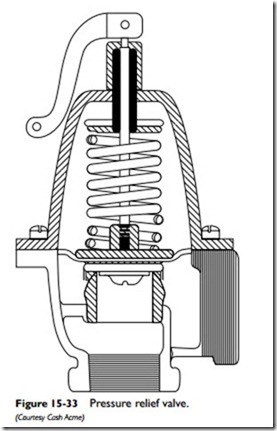Pressure Relief Valves
A steam boiler is equipped with a pressure relief valve (or valves), which opens and releases excess steam at or below the maximum allowable working pressure of the boiler (Figures 15-32 and 15-33). These are pop safety-relief valves designed to comply
with the requirements of the ASME Boiler and Pressure Vessel Code. They are also sometimes called safety valves, safety relief valves, or simply relief valves.
Pop safety valves exhaust the steam through holes drilled around the top of the spring housing. They function by “popping” wide open at the set pressure, remaining in that position until pressure has dropped the predetermined amount (commonly known as blowback or blowdown), and then snapping shut instantly. Lift levers and drain holes in the discharge side of the valve are required by ASME codes.
On the low-pressure boilers used in resi- dential steam heating systems, the pressure relief valve is commonly preset to open and release steam when a maximum pressure of
15 psi is reached in the boiler. The valve closes when the steam pressure once again falls below 15 psi.
Warning
NEVER use a pressure relief valve with a pres- sure relief rating higher than the maximum
working pressure of the boiler. If the boiler exceeds its maximum (safe) working pressure, it could rupture and explode at a pressure less than the rating of the pressure relief valve.


